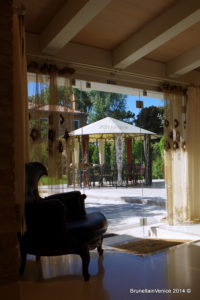Burano laces are true works of art and a testimonial to an ancient Venetian tradition. Two different techniques are used to produce laces. The Burano needle technique is derived from embroidery and uses only needle and thread without any cloth support. The Pellestrina bobbin lace technique is carried out on a tombolo, a cylindrical cushion stuffed with cloth. The first laces date back to 1500 when the work—consisted of geometric designs, flowers, animals, spirals, and rinceaux—was carried out only in refined homes. A strong push for its expansion was given by the dogaressa Morosina Morosini who, enamored of Burano’s art of lace, created a workshop at the end of the XVI century that employed 130 merlettaie, or lacemakers. Its production served, on one hand, to increase one’s own personal trousseau and, on the other, as a gift to be sent to female friends in Europe’s most important courts.
Beginning in 1978, under the auspices of a consortium created by Venice’s public corporations and the Fondazione Andriana Marcello, a conscious effort to rediscover and increase the cultural value of the art of lace got underway with the re-organization and cataloguing of the old school’s archives (1872-1970). The premises were renovated and transformed into exhibition space and, in 1981, the Lace Museum opened (becoming part of Venice’s municipal museums in 1995).
Information for visit Atelier Martina Vidal:
One of the islands in Venice’s lagoon, Burano is known for its brightly colored houses with laundry hung out to dry across its streets, its famous laces, and its delicious s-shaped cookies…all elements that make a stop on Burano mandatory and that can be easily done leaving from Cavallino Treporti. Using the ACTV, this island can be reached leaving from either the Punta Sabbioni or the Treporti terminal.
Once on the island of Burano, Martina Vidal Venezia (www.martinavidal.com) a lace atelier, can be found a short distance (about 150 meters) from the ACTV dock at the beginning of Via San Marco, on the right.
The Martina Vidal atelier has its premises in Palazzo dei Pittori, a popular haunt and inspiration for many artists of the 20th-century Venetian school of painting. Here, you can admire the expert lacemakers who still today create laces employing the same techniques used by their ancestors in 1500, and find unique collections of tablecloths, table-covers, table-centers, collars, bed sheets, handkerchiefs, fans, and wedding veils. Upon making a reservation using the web site’s Booking Form, the Martina Vidal staff will take you on a journey of discovery through collections of the workshop’s own modern production and of older, jealously guarded laces. You will have the possibility to see from up-close how lace is made, become acquainted with the elegance of this ancient craft, and perhaps, speaking with the lacemakers themselves, learn one of the secrets of this art.
The island of Burano can be reached via ACTV vehicles, water taxi, or private vehicle. ACTV Line 12 has both water-buses and motor boats every 20 or 30 minutes if you decide to leave from Venezia-Fondamenta Nuove, every hour if leaving from Venezia – St. Mark’s Square (Piazza San Marco) (check connections for the Punta Sabbioni Treporti Burano lines 14 and 12), every 30 minutes leaving from the “Ricevitoria” Treporti (lines 12). If you are cycling or other means other than the car, you can avoid car parking fees and find it more convenient to leave from the Treporti that is also accessible using ATVO public transport (bus schedules are listed in the attached pdf).







